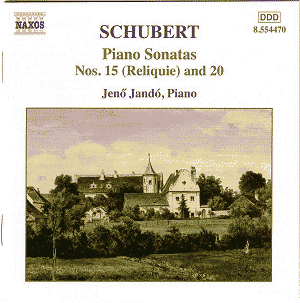We may think of Schubert as the composer of the "Unfinished",
but the B minor symphony was only one of many works he left incomplete
at his death. This was a composer of such teeming invention that he
was capable of completing two or even three songs on a single day, so
we shouldn’t be surprised to find him laying a piece aside almost in
mid-page when the fire of inspiration – or a new commission – demanded
something else. It’s frustrating, though, how often he then became side-tracked,
or forgot or lost interest in the earlier work.
The sonata D840 dates from April 1925 and was never
finished. The first two movements were completed and are played here,
but the remaining two exist only as fragments. (Some such fragments
have been convincingly resurrected and recorded by Martino Tirimo on
his EMI set of the complete sonatas.) The two movements of the D840
sonata amount to over twenty-five minutes of music, so this was to be
a large-scale work, and both movements are imposing pieces with much
of importance to say. Listening without a score one is struck by the
typically songlike feel of this music, by its huge melodic span, the
themes seemingly growing one from the other with apparently little conflict
between them. There is drama in both movements, but contrast is ingeniously
woven into the music, and the whole is remarkable in its cohesion. This
is a work well worth getting to know, even for those who are allergic
to fragments.
The sonata D959 is dated September 1828. Two other
sonatas seem to have been completed in this same month, and a letter
dated October 2 1828 has the composer trying to promote these works,
amongst others, with a view to publication. Six weeks later he was dead.
This sonata, too, is a large-scale work, coming in at almost forty minutes.
It’s one of those works where the influence of Beethoven is most strongly
felt, and enthusiasts of Beethoven’s keyboard works will readily hear
this influence at the very beginning, though the second theme is more
Schubertian and songful. The second movement is marked by a frequent
ostinato figure in the left hand, and by its dramatic middle section.
Many will think the scherzo recalls Beethoven again, though only Schubert
could be responsible for the finale. It begins with a most beguiling
tune, the world it creates totally unsuited, one would have thought,
to the finale of a large-scale work. It could have been lifted directly
from one of the composer’s songs; a strophic song, perhaps, complete,
here, with a wonderful little cadential refrain. We hear and rehear
this little melodic tag with a sweet rush of pleasure every time. The
final bars of the work bring an echo of the Beethovenian chords with
which the sonata began, but is it enough? This finale, can it – does
it – carry enough weight to close a forty minute sonata? What long hours
of pleasure await us as we try to decide!
Jenö Jandö’s performances here are thoroughly
recommendable. His Schubert playing has been characterised elsewhere
as seeking to bring out the more Beethovenian aspects of Schubert’s
keyboard writing, and on the showing of this disc I think this is fair
comment. His view of the pieces tends slightly more toward the dramatic
and less toward the lyrical. The first movements of both pieces, for
example, demonstrate from time to time a percussive style of playing
which does not seem out of place exactly, though significant enough
to make me want to draw attention to it. This works better, of course,
in these particular works than might be the case in other sonatas. However,
both Tirimo – whose EMI set previously mentioned seems, scandalously,
to be unavailable at the moment – and Murray Perahia achieve as much
drama with less recourse to force, and the difference between Jandö’s
bold and forthright "Reliquie" Sonata and that of Mitsuko
Uchida is as much as one can conceive of given that they are both playing
the same notes.
But this is not the way to listen to this disc, or
indeed, to most discs. Schubert’s sonatas can stand any number of different
approaches and each and every approach (unless totally wrongheaded,
and who’s to decide about that?) has something to tell us about the
composer. Jandö’s performances are authoritative and thoughtful;
they are individual; and he is more scrupulous in his attention to the
detail of the score than many a pianist. He is recorded in an almost
church-like acoustic, which will not please everybody, but apart from
that there really is no reason for the collector to hesitate.
William Hedley

